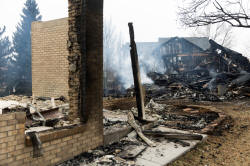|
In
Colorado, the wildfire season does not typically extend into the
winter thanks to snow cover and cold temperatures, but the
Marshall Fire is part of a general trend of longer fire seasons
and drier kindling in the Western U.S. as global temperatures
rise, KCC said.
"The Marshall Fire became the most destructive fire in
Colorado's history partially due to its location in the wildland-urban
interface — the region where unmanaged (or natural) vegetation
meets urban expansion," Jeff Amthor, assistant vice president of
research at risk modelling firm AIR, said.
There are 1,725 homes within the Marshall burn area, with a
total value of $825 million, AIR said, citing local officials.
The Marshall fire burned about 6,000 acres, with nearly 1,000
structures destroyed and over 100 damaged as of Tuesday, KCC
said. It follows the Pine Gulch Fire in 2020, Colorado's
largest.
In 2018, the Colorado State Forest Service reported data
indicating nearly half of the state's population now lives in
areas at risk from wildfires, an almost 50% jump in just five
years, Amthor said.
Climate change has been driving more so-called "secondary peril"
weather events that are smaller than hurricanes, for instance,
but less predictable. Other secondary perils include small- to
mid-size localized events like wildfires, winter storms and hail
storms.
"We do see this (Marshall Fire) as part of a broader trend of
more acute, 'secondary' perils," said David Flandro, head of
analytics at broker Howden.
These events create risk management challenges for insurers and
ultimately inflate premiums, according to insurance experts.
(Reporting by Noor Zainab Hussain in Bengaluru; Editing by
Devika Syamnath)
[© 2022 Thomson Reuters. All rights
reserved.]
This material may not be published,
broadcast, rewritten or redistributed.
Thompson Reuters is solely responsible for this content.

|
|





